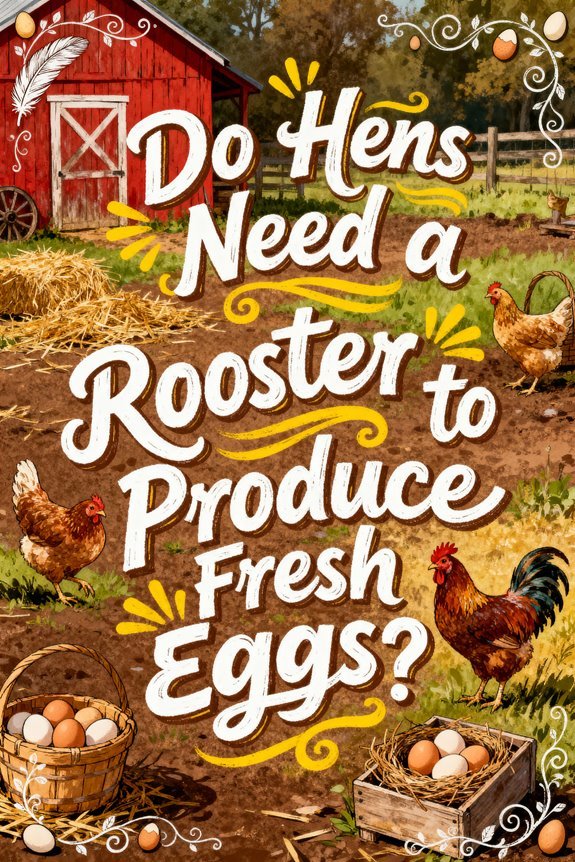Can Chickens Safely Eat Cantaloupe as a Treat?
You can safely feed cantaloupe to your chickens as a nutritious and hydrating treat. The fruit provides essential vitamins A, C, and K, while its high water content helps keep your flock hydrated, especially during hot weather. Limit cantaloupe treats to 10-15% of their total diet, and always remove seeds and rinds before serving. Monitor your chickens for any digestive issues, though proper preparation and portioning will maximize the benefits of this nutrient-rich supplement.
The Benefits of Feeding Cantaloupe to Chickens
When considering nutritional supplements for your flock, cantaloupe stands out as an exceptional treat that delivers multiple health benefits for chickens. This nutritious melon provides essential vitamins K and C, strengthening your birds’ immune systems and supporting bone development. The high beta-carotene content enhances feather quality and egg production, while the abundant potassium helps maintain proper electrolyte balance. Conventionally grown cantaloupes should be thoroughly washed to remove any chemical residues before feeding to chickens.
Adding cantaloupe variety to your chickens’ diet offers both nutritional and behavioral advantages. The fruit’s water content aids hydration, particularly during hot weather, while its fiber promotes healthy digestion. Like citrus fruits, cantaloupes should be offered in moderation to prevent digestive issues from excess sugar intake. As a form of chicken enrichment, cantaloupe encourages natural foraging behaviors when you scatter pieces in their run. The seeds are digestible and provide additional nutrients, making this fruit a complete and beneficial supplement for your flock’s diet. Similar to fresh vegetables, cantaloupe should be part of a balanced diet that prioritizes their regular feed for adequate protein intake.
Safety Guidelines for Serving Cantaloupe
Three essential safety protocols must be followed when serving cantaloupe to chickens: proper washing, portion control, and careful preparation. Washing techniques should thoroughly remove pesticides, chemicals, and potential pathogens from the fruit’s surface, regardless of its source. You’ll need to limit cantaloupe treats to 5% of your chickens’ total diet to prevent digestive issues and maintain nutritional balance.
When implementing serving suggestions, cut the fruit into small, manageable pieces and remove rinds and leaves. You should monitor your flock for signs of digestive upset after feeding and remove any uneaten portions promptly to prevent rodent attraction. Keep the coop area clean by disposing of leftover cantaloupe within 2-3 days, as proper hygiene reduces disease transmission risks. During hot summer weather, consider serving chilled cantaloupe as a refreshing treat for your flock.
Nutritional Value and Health Impact
Beyond proper serving methods, understanding cantaloupe’s nutritional composition reveals its significant health benefits for chickens. This fruit delivers essential vitamins A, C, and K, supporting immune function, cell growth, and bone development. Its rich beta carotene content enhances feather quality and egg coloration while providing antioxidant protection.
The high potassium and water content in cantaloupe aids metabolic benefits through improved electrolyte balance and hydration, particularly vital during hot weather. The fruit’s fiber promotes efficient nutrient absorption and digestive health by supporting gut microbiome function. Once or twice weekly feeding frequency ensures chickens receive optimal nutritional benefits without overindulgence. Additionally, cantaloupe’s calcium and phosphorus contribute to stronger bones and eggshells in laying hens. Combined with its antioxidant properties, these nutrients help reduce inflammation and enhance overall flock performance.
Proper Preparation Methods
To guarantee maximum safety and nutritional value, proper preparation of cantaloupe requires specific handling techniques before feeding it to chickens. Begin by thoroughly washing the fruit with clean water to remove dirt, pesticides, and potential contaminants. Your preparation methods should include cutting the cantaloupe into bite-sized pieces to prevent choking and guarantee even distribution among your flock. Just as with mineral-rich dandelions, fresh fruits and greens should be sourced from pesticide-free areas.
Similar to vitamin-rich cucumbers, cantaloupe makes an excellent hydrating treat for chickens when properly prepared. Store cut portions in the refrigerator and use within 2-3 days to maintain freshness. These feeding techniques can be enhanced by processing rinds and seeds separately – dry the rinds for snacks or grind seeds to mix with other treats. You’ll want to introduce cantaloupe gradually, perhaps mixed with familiar foods. During warm weather, try freezing small chunks to create revitalizing treats that help with hydration while maintaining proper portion control. With its 90% water content, cantaloupe is particularly effective at keeping chickens hydrated during hot summer months.
How Much Cantaloupe Should Chickens Eat
Finding the right balance when feeding cantaloupe to chickens requires careful attention to quantity limits and nutritional considerations. You’ll want to restrict cantaloupe serving sizes to no more than 5-10% of their daily diet, offering small, bite-sized pieces once or twice a day. This helps prevent digestive issues while maintaining proper nutrition. Since cantaloupe is rich in Vitamin C, it provides excellent nutritional benefits when fed in moderation.
Monitor your flock’s feeding frequency by limiting cantaloupe treats to a few times per week rather than daily. You’ll need to adjust portions based on flock size and age, with young chicks receiving smaller amounts than adults. Remove any uneaten fruit within 2-3 days to prevent spoilage. To maintain optimal health, ensure your chickens have pine-free bedding in their coop to avoid respiratory complications while enjoying their treats. During hot weather, you can increase frequency slightly for hydration, but always maintain moderation to guarantee your chickens don’t neglect their primary feed.
Managing Cantaloupe as a Summer Treat
Summer heat creates unique opportunities to maximize cantaloupe’s benefits for your chickens. When planning your summer feeding strategy, focus on cantaloupe sourcing that guarantees ripe, mold-free fruit to prevent digestive issues. You’ll want to serve this hydrating treat during cooler morning or evening hours to optimize consumption and nutrient absorption. Similar to unripe bananas, providing slightly underripe cantaloupe can help limit sugar intake while still delivering nutrients. Cut the cantaloupe into small, manageable pieces and monitor your flock’s intake to maintain proper dietary balance. While the seeds and rind are safe, the flesh provides the most nutritional value. Unlike capsaicin sensitivity, chickens process most fruits without issue, making cantaloupe a safe choice. Don’t let cantaloupe replace regular feed – it’s a supplement that works best when rotated with other hydrating treats. By carefully managing portion sizes and feeding frequency, you’ll help your chickens maintain proper hydration and energy levels throughout the summer months.
Understanding Your Chickens’ Response
Observing your chickens’ response to cantaloupe reveals fascinating insights into their nutritional preferences and physiological adaptations. You’ll notice distinct feeding preferences as your flock typically gravitates toward the seeds first, followed by the sweet flesh, while largely ignoring the rind. This chicken behavior demonstrates their natural ability to select nutrient-dense portions of the fruit. A healthy serving limit of 10-15 percent ensures proper dietary balance through treats.
Your birds’ enthusiasm for cantaloupe isn’t just about taste – it reflects their bodies’ recognition of valuable nutrients. They’ll often show increased interest during hot weather, when the fruit’s high water content and electrolytes become especially beneficial. Watch for signs of self-regulation, as chickens instinctively moderate their intake to avoid digestive issues, particularly with natural sugars and fiber content.
Potential Risks and Warning Signs
While chickens naturally gravitate toward cantaloupe, understanding its potential risks helps avert health complications in your flock. Watch for adverse effects like diarrhea, lethargy, or respiratory distress, which can indicate overfeeding or chemical exposure. You’ll need to limit cantaloupe to 5% of their diet to prevent digestive issues and obesity. Fresh cranberries and apples can provide safer alternatives when introducing new fruit treats. Creating elevated garden beds can help keep curious chickens from accessing and overeating fallen fruit pieces.
Implement careful observation techniques by monitoring your chickens’ droppings, behavior, and egg production after feeding cantaloupe. Remove uneaten fruit promptly to prevent pest attraction and bacterial growth. Like heat lamp hazards, spoiled fruit in the coop can create dangerous conditions that threaten your flock’s wellbeing. Wash the fruit thoroughly to eliminate chemical residues, and cut it into small pieces to prevent choking hazards. If you notice unusual symptoms like plumage loss or decreased appetite, consult a veterinarian immediately. These precautions promote your flock’s safety while enjoying this treat.
Integrating Cantaloupe Into a Balanced Diet
Integrating cantaloupe into your chickens’ diet requires careful attention to nutritional balance and portion control. While it’s a nutritious treat, cantaloupe shouldn’t replace commercial feed, which provides essential daily nutrients. You’ll want to maintain the fruit as an occasional supplement, offering roughly 60 calories per cup with moderate amounts of protein, carbohydrates, and fiber. Similar to oxalic acid content in other treats, cantaloupe is generally safe when fed in moderation.
To maximize dietary variety, you can include the entire fruit – flesh, seeds, and rind – as all parts are safe and digestible for chickens. This approach supports natural foraging behavior and increases your flock’s engagement with their food. When introducing cantaloupe, monitor your chickens’ response to verify they’re accepting the new treat without digestive issues. Remember to chop the fruit into manageable pieces to minimize waste and encourage consumption. For additional enrichment, consider combining cantaloupe with baked flock blocks to create engaging treats that support both nutrition and natural foraging instincts.


